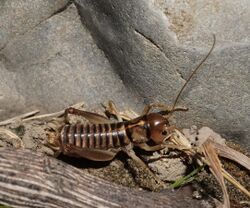Biology:Hemiandrus bilobatus
| Hemiandrus bilobatus | |
|---|---|

| |
| Scientific classification | |
| Domain: | Eukaryota |
| Kingdom: | Animalia |
| Phylum: | Arthropoda |
| Class: | Insecta |
| Order: | Orthoptera |
| Suborder: | Ensifera |
| Family: | Anostostomatidae |
| Genus: | Hemiandrus |
| Species: | H. bilobatus
|
| Binomial name | |
| Hemiandrus bilobatus Ander 1938
| |
| SynonymsSalmon 1950 | |
|
Hemiandrus similis | |
Hemiandrus bilobatus, the wine wētā[1] (or Cook Strait ground weta), is a species of ground weta endemic to New Zealand.[2] Being a ground weta, they are often found in burrows in the ground during the daytime (as they are nocturnal). The species is found in Wellington, on Mana Island and northern South Island and is classified as "Not Threatened".[3] This species of weta is unusual for an insect in that the female shows maternal care. She lays about 50 eggs in the same burrow she uses during the day and looks after her eggs until they hatch.[4]
Taxonomy
Hemiandrus bilobatus was first described in 1938. The specific name refers to the two lobes on the ventral surface of the abdominal tergites of adult females.[5] Hemiandrus bilobatus includes populations of ground weta found in the Awatere Valley[1] in Marlborough previously referred at as Hemiandrus "promontorius" or "Cape Campbell".[6][5][7]
Habitat/distribution
Hemiandrus bilobatus are endemic to the Wellington and Marlborough regions of New Zealand. They are often found in burrows in the ground during the day, and are only active at night.[8] During the night they are quite active on the ground, but are also found in on tree trunks and foliage.
Conservation
The New Zealand Department of Conservation classified this species as not threatened.[3]
Diet
Hemiandrus bilobatus are omnivorous. They have been observed eating invertebrates such as Deinacrida rugosa (giant weta), moths and beetle larvae and feeding on the young buds of grape vines.[9][4] Control of ground weta in vineyards has been tried using a number of approaches, the most effective method being a layer of mussel shells under the vines.[10]
Morphology
Cook Strait ground weta females have a very short ovipositor.[5]
Behaviour
Hemiandrus biolobatus come out of their burrows at night.[11] During mating males provide the female with a nuptial food gift.[8] The females share burrows with their eggs and care for nymphs.[9]
References
- ↑ 1.0 1.1 Trewick, Steven A.; Taylor-Smith, Briar; Morgan-Richards, Mary (2020). "Ecology and systematics of the wine wētā and allied species, with description of four new Hemiandrus species" (in en). New Zealand Journal of Zoology 48: 47–80. doi:10.1080/03014223.2020.1790396. ISSN 0301-4223.
- ↑ Johns PM 1997. The Gondwanaland weta: Family Anostostomatidae (formerly in Stenopelmatidae, Henicidae or Minermidae): nomenclatural problems, world checklist, new genera and species. Journal of Orthopteran Research 6: 125–138
- ↑ 3.0 3.1 Steve Trewick; Peter Johns; Rod Hitchmough; Jeremy Rolfe; Ian Stringer (2014). The conservation status of New Zealand Orthoptera, 2014. https://www.doc.govt.nz/Documents/science-and-technical/nztcs16entire.pdf.
- ↑ 4.0 4.1 Nboyine, JA; Boyer, S; Saville, D; Smith, MJ; Wratten, SD (2016). "Ground wētā in vines of the Awatere Valley, Marlborough: biology, density and distribution" (in en). New Zealand Journal of Zoology 43 (4): 336–350. doi:10.1080/03014223.2016.1193548. ISSN 0301-4223.
- ↑ 5.0 5.1 5.2 Johns PM 2001. Distribution and conservation status of ground weta, Hemiandrus species (Orthoptera: Anostostomatidae). Science for Conservation 180, New Zealand Department of Conservation, Wellington, New Zealand.
- ↑ Taylor Smith, Briar (2015). Evolution of diversity: analysis of species and speciation in Hemiandrus ground weta. New Zealand: Massey University.
- ↑ CHAPPELL, ESTA M.; TREWICK, STEVEN A.; MORGAN-RICHARDS, MARY (2011-10-24). "Shape and sound reveal genetic cohesion not speciation in the New Zealand orthopteran, Hemiandrus pallitarsis, despite high mitochondrial DNA divergence" (in en). Biological Journal of the Linnean Society 105 (1): 169–186. doi:10.1111/j.1095-8312.2011.01777.x. ISSN 0024-4066.
- ↑ 8.0 8.1 Gwynne, D. T. (2014). "A secondary copulatory structure in a female insect: a clasp for a nuptial meal?". Naturwissenschaften 89 (3): 125–127. doi:10.1007/s00114-002-0298-y. PMID 12046632.
- ↑ 9.0 9.1 Smith, BL Taylor; Morgan-Richards, M.; Trewick, SA (2013). "New Zealand ground wētā (Anostostomatidae: Hemiandrus): descriptions of two species with notes on their biology" (in en). New Zealand Journal of Zoology 40 (4): 314–329. doi:10.1080/03014223.2013.804422. ISSN 0301-4223.
- ↑ Nboyine, Jerry Asalma; Boyer, Stephane; Saville, David J.; Wratten, Stephen David (2017-02-21). "Agroecological management of a soil-dwelling orthopteran pest in vineyards" (in en). Insect Science 25 (3): 475–486. doi:10.1111/1744-7917.12425. ISSN 1672-9609. PMID 27891761.
- ↑ Watts, Corinne; Thornburrow, Danny; Stringer, Ian; Cave, Vanessa (2017-12-06). "Population expansion by Cook Strait giant wētā, Deinacrida rugosa (Orthoptera: Anostostomatidae), following translocation to Matiu/Somes Island, New Zealand, and subsequent changes in abundance" (in en). Journal of Orthoptera Research 26 (2): 171–180. doi:10.3897/jor.26.21712. ISSN 1937-2426. https://zenodo.org/record/1140999.
Wikidata ☰ Q11843913 entry
 |

